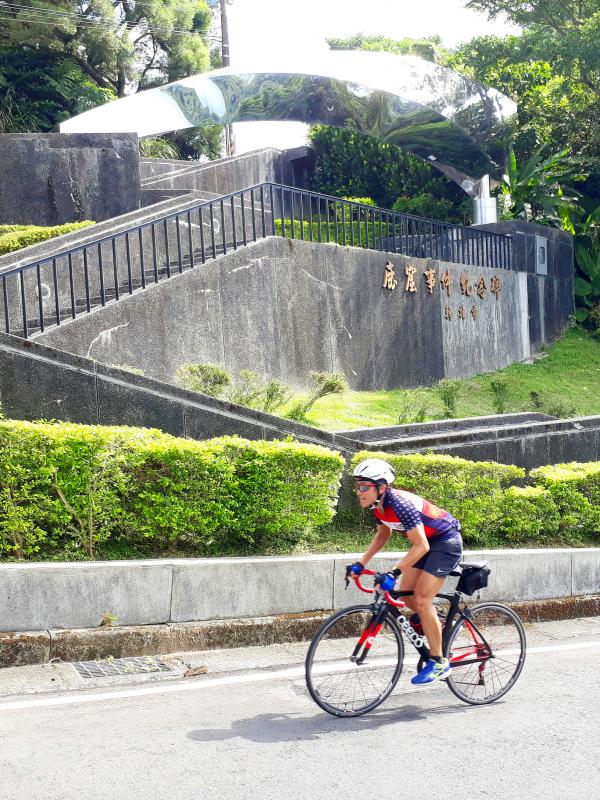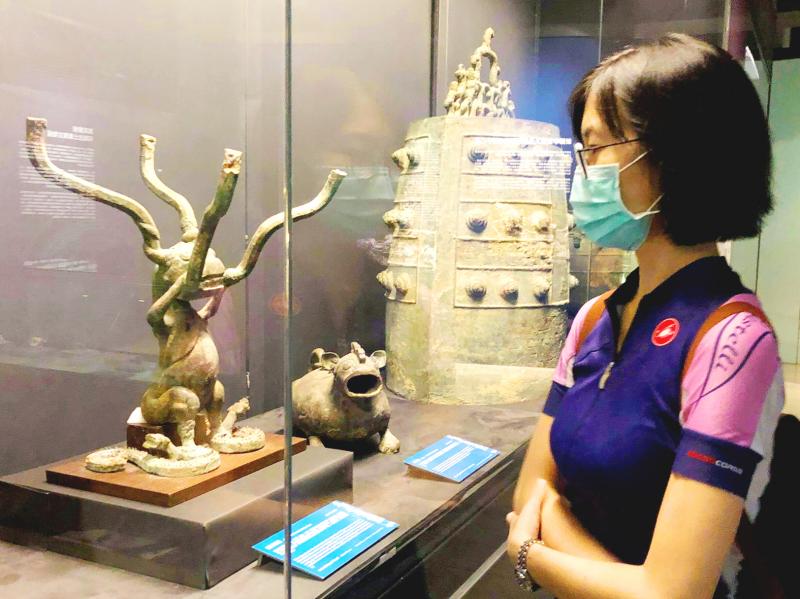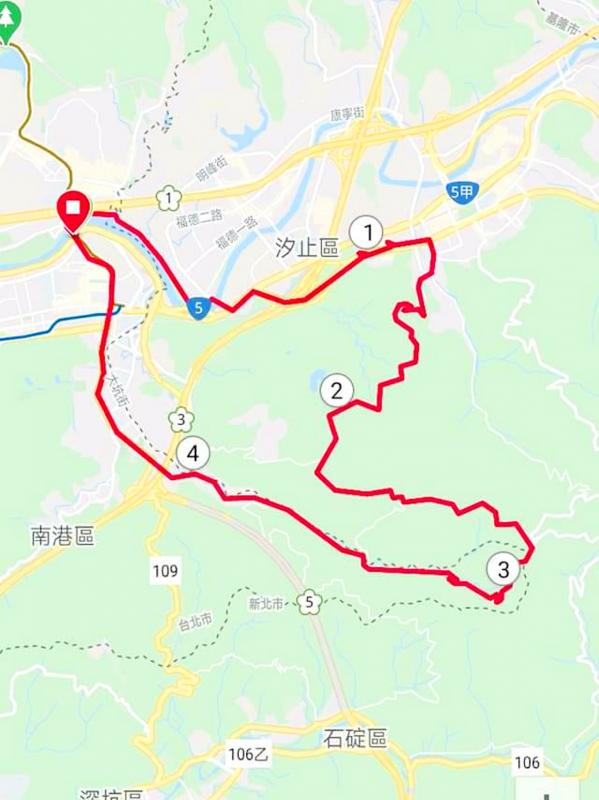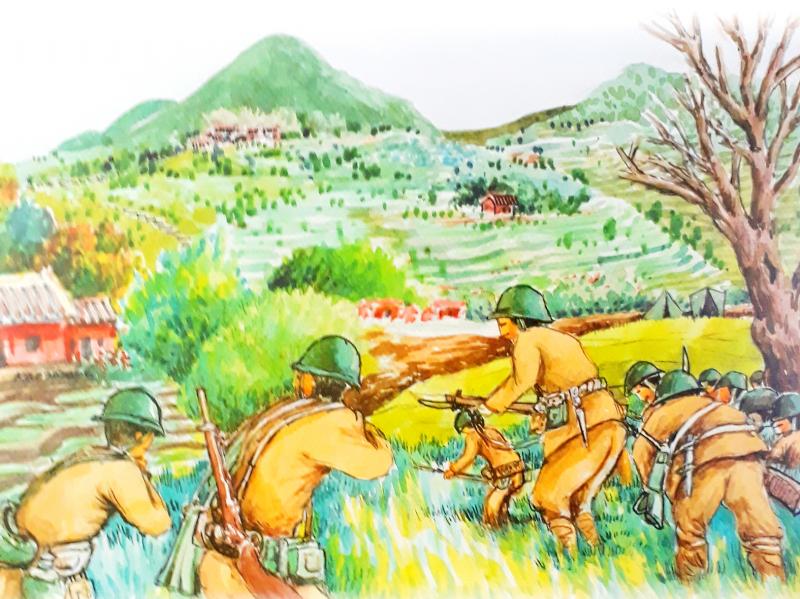As if the climbs and views and snacks and companions of cycling in Taiwan aren’t sufficient, the GPS-generation of route-planners are now using apps such as Strava and Endomondo to create works of art as they ride.
One such is nicknamed the Dove Road of Sijhih (汐鴿路), a 25km ride that follows the riverside bike path from the Nangang-Neihu Bridge (南湖橋) to New Taipei City’s Sijhih District (汐止), climbs around 400m up the Sijhih-Shiding Road (汐碇路), before dropping back down past Academia Sinica to generate a very dove-like pattern.
Originally called Kippanas by indigenous Ketagalan people and transliterated into Hoklo (more commonly known as Taiwanese) as phangasi (峰仔峙), Sijhih’s modern Chinese name means “tide stops” and indicates it is located at the tidal limit of the Keelung River and is therefore essentially at sea level. Once a sleepy suburb on the edge of the Taipei Plain, it developed rapidly since the 1980s, and is now home to many of Taiwan’s major electronics headquarters, including Acer and Garmin.

Photo: Mark Caltonhill
To the north, though not on today’s menu, is a choice of three popular routes up Wujhih Mountain (五指山, “Five Finger Mountain”). At the top is the military cemetery designed as the final resting place for former president Chiang Kai-shek (蔣介石) and his son, former president Chiang Ching-kuo (蔣經國). To date, however, its top-flight resident is the mostly-forgotten Yen Chia-kan (嚴家淦, president from 1975 to 1978) though starting Oct. 7, he will be joined by recently deceased Lee Teng-hui (李登輝, president from 1988 to 2000).
Similarly, to the south, three routes climb to Luku (鹿窟, literally “Deer Cave,” but more likely the transliteration of an Aboriginal name). Two rise quite precipitously, but today’s dove-shaped route takes the westernmost, which fortunately is also the easiest. Eight kilometers and around 400m of ascent bring you to a plateau, marked by a sculpture of stone and twisted steel.
Identified as the Luku Incident Memorial (鹿窟事件紀念碑), information in Chinese relates that it marks the site of what was possibly the largest political showdown of the two Chiangs’ 38 years of martial law, also known as the period of White Terror (白色恐怖, 1949 to 1987). On the pretext of arresting two so-called communist sympathizers, Chen Pen-chiang (陳本江) and his brother Chen Tung-ho (陳通和), 10,000 troops and armed police entered the area in December 1952.

Photo: Mark Caltonhill
ARREST AND TORTURE
This ended with the arrest, torture and imprisonment of as many as 400 local, poorly educated farmers and miners. Ninety-eight were given prison sentences and 35 were sentenced to death, leaving only women and children at liberty.
If time and energy allow, turn off your GPS so as not to ruin your upcoming work of art, and cycle the 1km uphill to the Guangming Zen Temple (光明禪寺). Now a tranquil Buddhist monastery, in 1952 this was where many of the innocent farmers were taken for questioning and, according to oral accounts, torture.

Photo: Mark Caltonhill
Back on dove’s tail, descending from the memorial brings you to the Nangang Tea Processing Demonstration Center (南港茶葉製造示範場, open Tuesdays to Sundays, from 9am to 5pm).
For those in a rush, it is a good place to refill water bottles for free; for those not pressed for time, there are exhibitions relating to the baozhong tea (包種茶) grown in this area since the 1880s, and demonstrations of equipment and techniques used to transform botanical produce into the lightly oxidized beverage somewhere between green teas and oolong. Naturally, there is the chance to taste various infusions and, during mealtimes, tea-flavored eggs, tofu and jelly, as well as more substantial meals are on sale.
On weekends, you may well meet Pan Wen-pin (潘文彬), a lecturer at Nangang Community College. He is more than happy to explain everything local, from the history of the tea farms and details of tea-drinking etiquette, to local geography and contemporary environmental developments. Unfortunately, like the memorial, he is only available in a Chinese-language version.

Photo: Mark Caltonhill
The center is also a good place to leave your bike should you fancy hiking one of the many trails in the surrounding woods (though once again, don’t forget that GPS). Highlights include vestiges of the short-lived coal-mining activities, “hundred-year-old” camphor and osmanthus trees, a couple of old suspension bridges and various Qing Dynasty farmhouses.
Great views over the Taipei Basin are to be had looking west, while eastward the hills stretch out toward Keelung and the Pacific Ocean, with their hint of open-country cycling all the way to Taiwan’s southern tip.
That’s for another day, however, and with your GPS switched back on, follow the road as it descends pleasantly past tea farms to Nangang. Here, innumerable food options are available to those already suffering low blood sugar after expending around 500 kcals for this short couple of hours’ ride.
ETHNOLOGY AND ARCHAEOLOGY
For those still going strong and with an interest in Taiwan’s cultural inheritances, on Wednesdays and weekends another short 300m diversion is on offer to the Museum of the Institute of Ethnology (民族學研究所博物館) and Museum of the Institute of History and Philology (歷史文物陳列館) at Academia Sinica (中央研究院).
The former offers a broad-strokes introduction to Taiwan’s various Aboriginal groups and the diversity of its Han Chinese cultures. Particularly striking, however, is the institute’s external architecture, which was designed by renowned architect Han Bao-de (漢寶德) and incorporates Minnan stylistic elements of southern Fujian Province, from where the majority of immigrants came in the 17th to 19th centuries.
The latter really deserves a full day visit of its own. Its permanent collections of archaeological finds from all over China are frequently borrowed for special exhibitions at the National Palace Museum and elsewhere, but can be seen here for free.
These include 7,000 Paleolithic items, 13,000 inscribed wooden slips from the Chinese frontier in the Han Dynasty, and over 70,000 pieces, including bronzeware and Oracle Bone inscriptions, excavated from the Shang Dynasty ruins at Anyang in Henan Province. There is currently also a temporary exhibition of Taiwan’s archaeological discoveries dating from 30,000 years ago up to the large-scale arrival of Han Chinese and Western immigrants in the 17th century.
OK, after this you probably do deserve a sit down and a bite to eat. But don’t forget to finish the last 3km back to the starting point and complete your picture of a dove.

We lay transfixed under our blankets as the silhouettes of manta rays temporarily eclipsed the moon above us, and flickers of shadow at our feet revealed smaller fish darting in and out of the shelter of the sunken ship. Unwilling to close our eyes against this magnificent spectacle, we continued to watch, oohing and aahing, until the darkness and the exhaustion of the day’s events finally caught up with us and we fell into a deep slumber. Falling asleep under 1.5 million gallons of seawater in relative comfort was undoubtedly the highlight of the weekend, but the rest of the tour

Youngdoung Tenzin is living history of modern Tibet. The Chinese government on Dec. 22 last year sanctioned him along with 19 other Canadians who were associated with the Canada Tibet Committee and the Uighur Rights Advocacy Project. A former political chair of the Canadian Tibetan Association of Ontario and community outreach manager for the Canada Tibet Committee, he is now a lecturer and researcher in Environmental Chemistry at the University of Toronto. “I was born into a nomadic Tibetan family in Tibet,” he says. “I came to India in 1999, when I was 11. I even met [His Holiness] the 14th the Dalai

Following the rollercoaster ride of 2025, next year is already shaping up to be dramatic. The ongoing constitutional crises and the nine-in-one local elections are already dominating the landscape. The constitutional crises are the ones to lose sleep over. Though much business is still being conducted, crucial items such as next year’s budget, civil servant pensions and the proposed eight-year NT$1.25 trillion (approx US$40 billion) special defense budget are still being contested. There are, however, two glimmers of hope. One is that the legally contested move by five of the eight grand justices on the Constitutional Court’s ad hoc move

Stepping off the busy through-road at Yongan Market Station, lights flashing, horns honking, I turn down a small side street and into the warm embrace of my favorite hole-in-the-wall gem, the Hoi An Banh Mi shop (越南會安麵包), red flags and yellow lanterns waving outside. “Little sister, we were wondering where you’ve been, we haven’t seen you in ages!” the owners call out with a smile. It’s been seven days. The restaurant is run by Huang Jin-chuan (黃錦泉), who is married to a local, and her little sister Eva, who helps out on weekends, having also moved to New Taipei